Consider the following. (All text in italics is by Miebach).
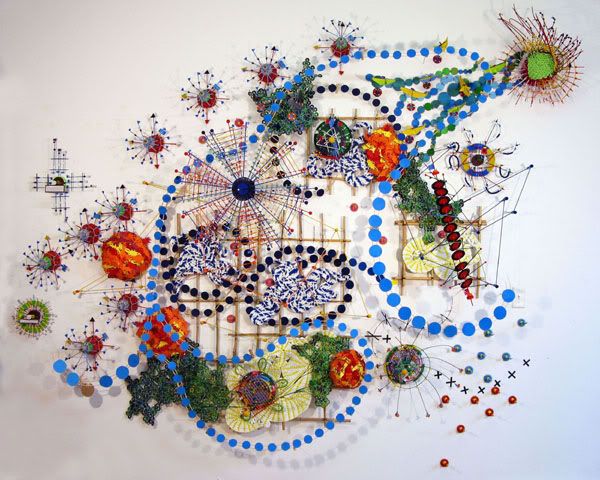
Changing Water - Gulf of Maine
mixed media, data
(proto-type for a 20 foot long wall installation), 20’x10’ x 1’, 2011
This semi-kinetic piece looks at the interaction between meteorological conditions and marine environments in the Gulf of Maine.
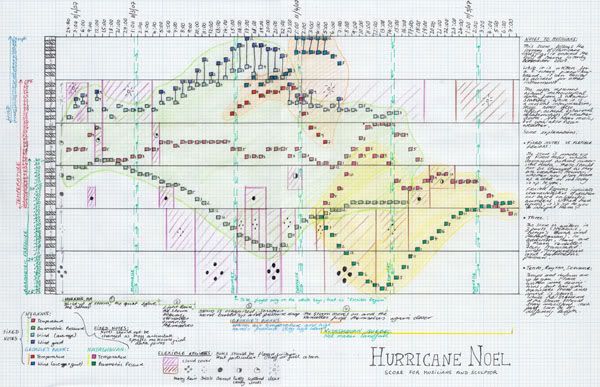
Hurricane Noel
Ink, data
11”x17”, 2010
Using meteorological information from two weather stations (Hyannis, MA and Natashquan, Quebec) and one off shore buoy (George’s Bank), this score translates barometric, wind and temperature readings to try to discern the path Hurricane Noel took as it entered the Gulf of Maine during Nov 3-5, 2007. So far this score has been interpreted by “Butter”, a musical band from Provincetown, MA, and the Axis Ensemble, a new music group formed by composition graduate student from Tufts University.
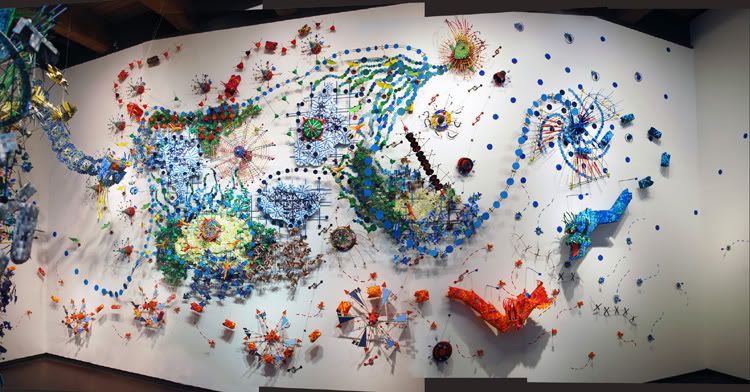
“Changing Waters” looks at the meteorological and oceanic interactions within the Gulf of Maine. Using data from NOAA and GOMOSS buoys within the Gulf of Maine, as well as weather stations along the coast, I am translating data that explores the seasonal variations of marine life by looking at the interactions of atmospheric and marine data. Elements of the rich New England fishing history are also included. This large-scale installation consists of a large wall installation (33 feet wide) that plots information through the geographic anchors of a map of the Gulf of Maine, as well as a series of large, hanging structures (10 feet high) that look at more specific biological, chemical or geophysical relationships between marine ecosystems and weather patterns.
On display at the Fuller Craft Museum, Jan 15 – Sept 25, 2011. (www.fullercraft.org)
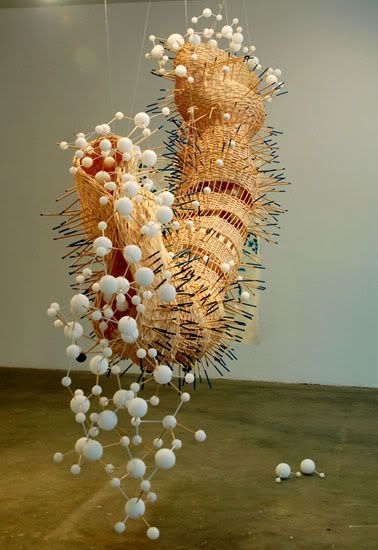
Antarctic Tidal Rhythms
Reed, wood, styrofoam, data, 8’ x 6’ x 3’, 2006
Using a base of 24 hours, this piece converts various layers of data (Jan-Dec 2005) related to the gravitational influence of both Sun and Moon on the Antarctic environment. The inner structure converts sunrise/set and moonrise/set data into the woven structure, with every weave representing one hour. Additional data translated include tide readings moon phases, solar noon readings and the molecular structure of ice.
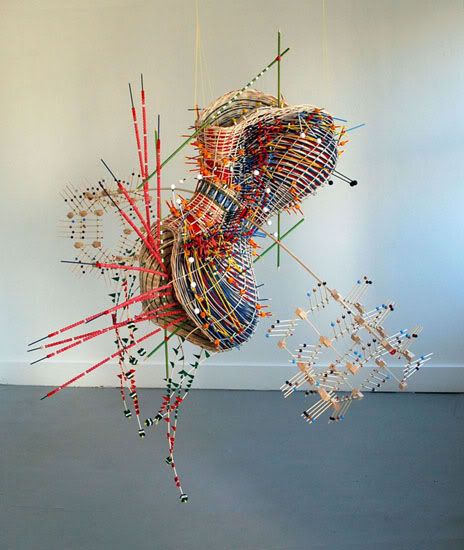
Warm Winter
Reed, wood, data, 6’x 5’x6’, 2007
Using a base of 24 hours, this piece converts locally collected data (at Herring Cove) , with data from regional buoys (source: Gulf of Maine Observation System) and historical data (source: www.wunderground.com, NOAA and U.S. Naval Observatory). Data converted includes temperature (air, water, soil), wind speed and direction, tides and moon phases. The time frame translated is Dec 2006 – January 2007.
I've seen other artists who employ scientific data as a starting point for their art. But we can contrast what Miebach does with say, the paintings of Jonathan Zawada (below) in that she preserves the spatiotemporal relations of - and hence, if you know the mapping, the information encoded in - the data by literally 'plotting' in her basketwoven grid on on a musical score, rather than merely employing it as an aesthetic inspiration. (Toril Johannessen on the other hand, simply - and beautifully - plots data, just as any scientist would, but perhaps with a more panache, and allows the carefully selected time series speak for themselves). Further Miebach, by gathering her own data, combining it with public data sources and observing how for instance temperatures are affecting local flora and fauna, she is much more intimately tied the science, and her work is more informed by observation. I am tickled by the times series selected by Zawada and find his paintings pleasing, but I am awed by what Miebach does. I've quoted her directly so as to appear reasonable and avoid writing something uncouth like, "OMG this is the most amazing thing evar!"
Jonathan Zawada modelled 2D time series (somewhat regretably referred to "graph data" but that's really unlikely to annoy anyone unless, like me, they spend a lot of time doing time series analysis, so all non-scientists should simply ignore this digression) into 3D landscapes which he then painted in oil on canvas. Each canvas was presented behind a plinth with a mirror on which the original time series is printed.

Earth Movers, Oil on linen 39.37 x 75.59 inches 100 x 192 cm
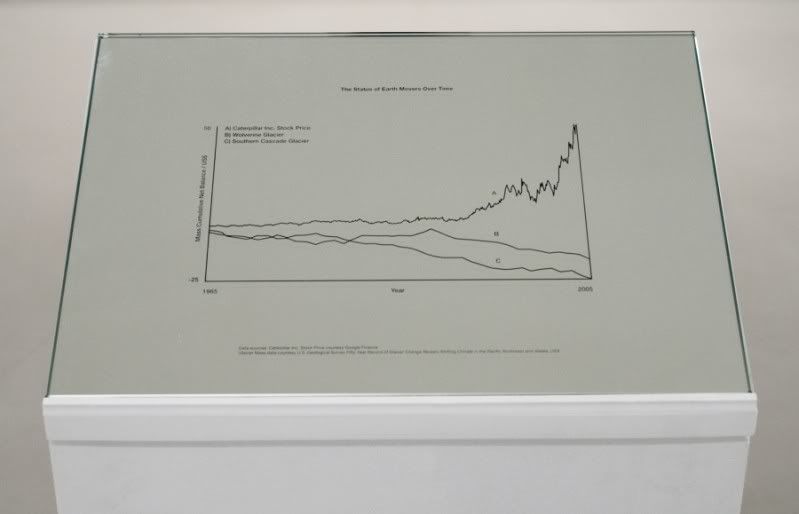
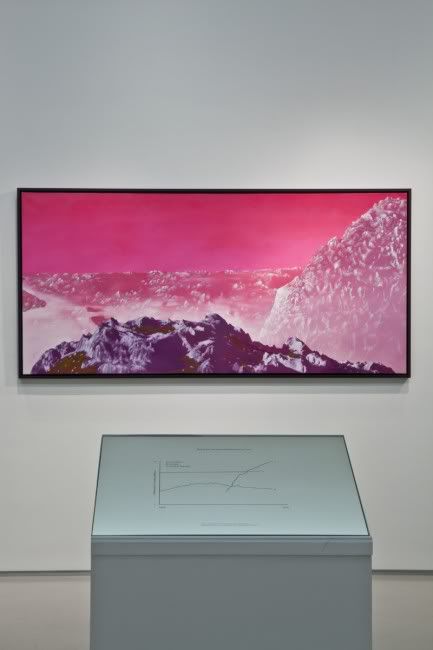
photo showing Populations, Oil on linen 37.01 x 78.74 inches 94 x 200 cm

Flight 77, Oil on linen 59.06 x 46.06 inches149.9 x 117 cm (altitude versus time data)






Wonderful post, Minouette. Thanks for the introduction to these artists. The last project I initiated involved audio waveforms-- it's only in its preliminary stages for sure. The above work has provided me with some serious inspiration to move forward!
ReplyDeleteThanks very much Tara! 'Art about science' (as I call) it is a bit of an obsession with me. Audio waveforms sound (no pun intended) like an interesting starting point and I'm intrigued to see what you come up with.
ReplyDeleteBy the way, I enjoyed surprising a friend with a gift on which I had tied one of your plaster fingers amongst the ribbons, like the extra finger one always needs when tying up a package.
Natalie Miebach's work is just wonderful! Thanks for the introduction.
ReplyDeleteMy pleasure!
ReplyDelete